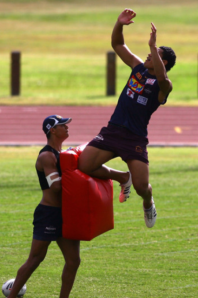
In this article I want to challenge your thinking on catching an attacking high ball. For the moment, at least, we will consider the important skill set of defensive catching on a separate occasion.
This wil be the parte II.
Part I on: http://www.rugbyandfitness.blogspot.com.ar/2013/09/catching-high-ball-in-rugby-part-i.html
“How often do we see this, for safety’s sake?’…
This wil be the parte II.
Part I on: http://www.rugbyandfitness.blogspot.com.ar/2013/09/catching-high-ball-in-rugby-part-i.html
“How often do we see this, for safety’s sake?’…
The image above could very well be another missed opportunity to score or further promote the ball in phase play that often presents with broken defensive shape. If the try line is near then clear possession will often equate to a try scored, even if not from that phase.
It is a non negotiable that a player enters an aerial contest with the intention of “owning”the rugby ball. Half-Hearted attempts and a fear of knocking forward have no place with so much at stake.
With this in mind a catcher must only have eyes for the ball, and this begins the momentthe ball is kicked. The best catchers I have observed, have less self preservation andmore focus on the ball.
A catcher that is watching the kicker “shape-up” will gain necessary visual cues that will determine timing, angle and tempo of approach to catch. In other words, pay fullattention to the kicker.
- With eyes fixed on ball in flight, the catcher makes his approach to where he judges the ball to land. Note- this is not necessarily where the contest forms, they must use only their judgement of this situation. This is the opportunity for the player to adjust stride length, pace & tempo.
- At the point the player judges the ball to be landing, it is time to transition into theVertical Leap Phase. Players should always turn into the catch.
- The aim is to meet the ball at its highest point possible, no good to jump but catch the ball after you land or on the way down.
- The last stride into the leap is important for generating power ( a bit like long jump but aiming for height, not length). For vertical leap the player must jump off inside leg powerfully driving through the ground.
This “external cue” may help get extra height! I call this a J-Line, the body now follows the twist and moves into the line of the ball.
At this point it is critical for me to say that each catch attempt, the player must bring their body behind & into the line of flight path of the ball to be successful with this. It’s easier to stay strong, stable and balanced from this position.
- The arms should now 3/4 extended outwards and above the head, ensuring eyescan still see the ball.
- Hands will come close together forming a W shape behind the ball. It is important that players maintain strong hands with soft fingers when catching.
An upright and balanced body position allows for better chance of landing on feet andtransitioning to pass, run, fall and score etc…
Start with using players catching off hit shields held by stationery players within the vicinity of the try line.
Practice throwing balls up first getting the fundamentals right before progressing to having your kickers put the ball up. Remember it’s a catching drill and sometimes poor kicking lets this drill down so its ok if you throw balls up to practice good body position first.
This is of course is a simple instruction format made up of some important fundamentals. Successful transfer is achieved from having your kickers deliver under pressure, andcatchers having to negate and compete with defenders in the air. As a coach, you be the judge on how you provide those progressions within your training structure, but you must be able to identify with the technical aspects of catching to be able to instruct and improve your team.
“Dominant vertical leap, with eyes behind ball, hands in W position”…
So it is, that in the modern era of rugby we are all looking for a sustainable attacking advantage over our opponents. Defensive systems are becoming rather sophisticated with try scoring opportunities far from abundant. Whilst I’m not suggesting this is the only option, I do believe a good team is far from predictable and may offer several attacking avenues to penetrate defences.
Is it time that you looked to the air?
By Stuart Lierich / Twitter @KickCoaching
Link: http://kickcoaching.com.au/2013/07/31/rugby-catching-and-the-high-ball/
www.rugbyandfitness.com
www.rugbyandfitness.com
Twitter @rugbyandfitness
Facebook.com/rugbyandfitness
No hay comentarios:
Publicar un comentario